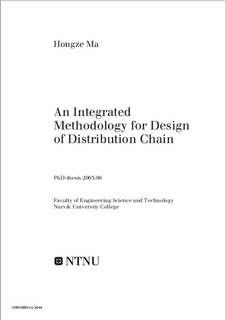| dc.description.abstract | In today’s buyer market, the key question for an enterprise is how to sell products rather than how to produce products. That is why the study on distribution part of a supply chain is attracting extensive attentions from both academics and industry. In this dissertation, an integrated methodology is developed to design a istribution chain. According to this methodology, a distribution chain is designed by following three phases:
(1) Problem formulation phase. In this phase, the present situation for the host enterprise is analyzed, and the goal to design this distribution chain is set. By this analysis, the objective and constraints for designing the distribution chain are determined.
(2) System design phase. In this phase, first, all possible istributors are evaluated through a trilogy:
-Determine the factors needed to be considered when evaluating a possible distributor.
- Collect data from geographically distributed distributors by a mobile agent based information acquisition system.
- Evaluate possible distributors quantitatively by a FL (Fuzzy logic)-ABL (Array Based Logic) inference engine.
After evaluation, a set of eligible distributors are selected as andidates for designing this distribution chain.
With these candidates at hand, a set of models, formulae and lgorithms are developed to design a distribution chain. To determine the exact customer demand at each retailer (candidate), an ANN Artificial Neural Network) model is developed to estimate the retailer’s market share in its customer zone. By this estimated market share, the customer demands at retailers are determined, and the configuration of a distribution chain, including the number and location of distributors, is determined by MIP (Mixed Integer Programming) model. The inventory control parameters at each node of this distribution chain are optimized by probability theory, and routes for vehicles to deliver products between different nodes are optimized by genetic algorithm. After this, the designing process for a distribution chain is finished.
(3) Performance evaluation phase. To verify the design result, a new form of Petri net, combinatorial Petri net, is developed, and the performance of the distribution chain designed above is evaluated by this newly developed Petri net form. If the performance is not satisfactory, the distribution chain needs to be re-designed.
All models, algorithms and formulae used in this dissertation have been implemented by computer applications. This gives possibility to realize automatic design of a distribution chain. At last, a umerical example is given to illustrate how to apply this methodology in practice. | nb_NO |
